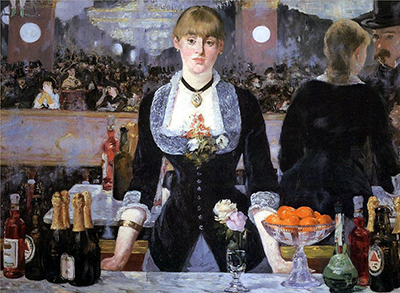Édouard Manet's last major work, and his most famous, was A Bar at the Folies-Bergère. He exhibited it at the Paris Salon in 1882 before his death in April of the following year. The piece has been the subject of much debate over the seemingly awkward perspective.
As Manet was a realist painter, he is known for paying great attention to detail. He has meticulously painted in dozens of figures in the background of this painting behind the bar maid. However, these figures are not in reality behind the barmaid at all, but are in front of her, having been reflected in a mirror in the background. The gold frame of this mirror can be seen running just behind her wrists. This is the source of the controversy over this painting. Certainly, the mirror is central to the theme of the painting, as the barmaid appears aloof and guarded, or even sad, when the viewer looks directly at her, yet in the reflection from the mirror appears to lean in eagerly toward a patron. It is also likely a small nod to painting which included a mirror in its background, Las Meninas by Diego Velázquez, who Manet held in high esteem.
The problem, though, is that at first the reflections of the barmaid and the man on the right don't appear to line up. Some have suggested that the man reflected is intended to be the viewer, and that Manet simply altered the perspective for aesthetic reasons, as otherwise both the reflection of the viewer and the barmaid should appear directly behind her. The other natural assumption is that the man is standing to the left just outside of the viewer’s eye line, but even this theory only accounts for the position of the reflection of the man, not the off-centre reflection of the barmaid. Many critical reviews and academic papers have been written on this subject, but a photo from a staged reconstruction of the painting in 2000 by art historian Dr Malcolm Park showed the scene just as Manet painted it. It revealed that the confounding perspective is perhaps because Manet has painted a small section of a larger view.
Dr Park was able to recreate the painting by placing the viewpoint further back and to the right of the viewer of the painting to correctly align the reflections. By then cropping the image to just a small section to the left of this viewpoint, he was able to replicate the frame of view for the painting. Essentially, the apparent problem with A Bar at the Folies-Bergère is that Manet has made a departure from convention by not placing the viewer of the painting at the central viewpoint of the scene. To create this complex work, Manet made several preliminary sketches at the Folies-Bergère itself, before returning to his studio to begin the piece. It was painted in oils on canvas. He used one of the real barmaids from the establishment, Suzon, as his model. He had also previously painted her the year before in Model for the barmaid of A Bar at the Folies-Bergère.
The original sketches showed the barmaid turned more towards the man reflected in the picture. X-rays of the piece similarly reveal that Manet started with her in this position, in a much more vulnerable gesture with her arms crossed at her waist and one hand grasping her other wrist. Evidently, he decided to paint over this to place her in a more central position looking out directly at the viewer. Manet has also included in this painting many interesting details of the Folies-Bergère. It was a nightclub and music hall for the Parisian upper middle class, particularly popular with artists seeking inspiration. It provided a range of entertainment, including cabaret, ballet, opera and acrobatics. To illustrate this, in the top left corner of the painting, a trapeze performer’s legs can be seen hanging down. A woman with opera glasses in the audience also raises the question of what else is happening in the performance.
The Folies-Bergère was also known for its welcoming attitude towards prostitution. In fact, many of the barmaids were prostitutes as well. Manet has included a bowl of oranges next to Suzon in this painting, a symbol which he consistently used to allude to prostitution. He had courted controversy in the past for his less subtle depictions of prostitutes at work in the pieces The Luncheon on the Grass and Olympia, painted in 1862 and 1863, respectively. Finally, he has also included a specific brand of beer in this piece. The red triangle logo on the bottles identifies them as Bass Pale Ale. This brewery was started in 1777, and is still producing today. Some consider this inclusion of English rather than German beer evidence of French ill will towards Germany in the wake of the Franco-Prussian War of the early 1870s.
The enduring popularity of A Bar at the Folies-Bergère has inspired references to it in many pieces of pop culture. Australian artist, John Brack, paints a similar scene in his 1954 work. The Bar, while Canadian photographer John Wall alluded to it in his Picture for Women. Spoofs of the piece appear in the films The Private Affairs of Bel Ami and Coming to America, and it has even inspired a ballet and a song. The piece originally belonged to Emmanuel Chabrier, Manet’s neighbour, who hung it above his piano. Measuring 96 centimetres by 130 centimetres, it certainly would have been a statement piece. It eventually made its way into the possession of English art collector Samuel Courtauld, who donated it in 1934 to the Courtauld Gallery in London, which he co-founded.




